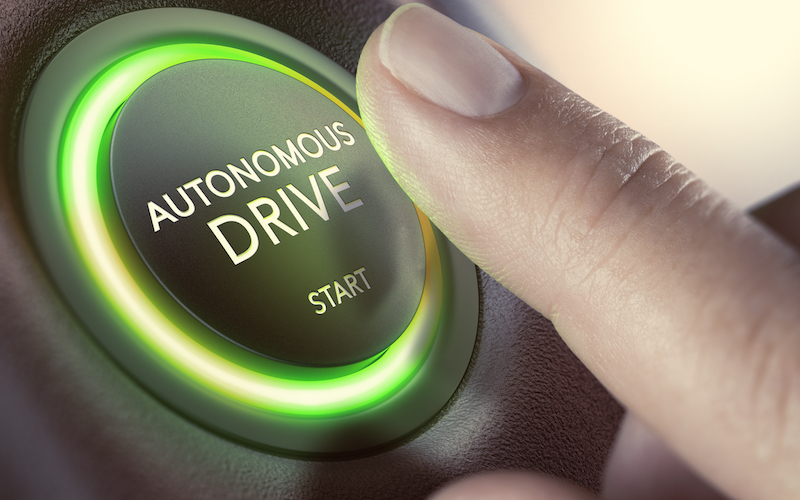
Self-driving cars are already on our streets – so how do we prepare now to integrate them into our transportation network? Photo: Oliver Le Moal via Shutterstock
In part one of our mythbusting series about self-driving cars, we talked about how self-driving cars are no longer a dream of the future, but are here now. While we’re still in the early stages of testing and adoption, it’s expected that we will see a major proliferation of self-driving cars here in the States soon.
That means we need to plan for them now – and what a proliferation of self-driving cars will mean for our roadways, our environment, and our daily lives.
We pick up our mythbusting with:
Myth # 3: Eventually We’ll All Have Self-Driving Cars
We have all gotten used to the paradigm of personal car ownership — especially those of us who don’t live and work in major metropolitan areas (sorry, Providence!). So it’s only natural for me to imagine that I’ll someday replace my Prius and buy a car that drives itself. But that’s probably not the way things should go.
In fact, as self-driving cars gradually replace their traditional counterparts, it won’t make sense for people to maintain today’s level of individual vehicle ownership. That’s because a single self-driving car could replace up to 13 individually owned vehicles while maintaining traffic patterns that are similar to today’s.
But the likely rise of shared self-driving cars doesn’t mean private car ownership will be out the window. There will still be a place for personal vehicles – it’s just that that place might be the proverbial back seat, with shared vehicles serving as the first option for most people.
Granted, this isn’t going to happen tomorrow, or the next day, or the day after that. But, remember, self-driving cars will be big in the U.S. before we know it. We’re not talking about a future that only our kids and grandkids will see – we’re talking about changes in our lifetimes, which is why we need to be smart about self-driving cars now.
We should implement policies today that encourage shared vehicle use by making shared self-driving cars cheaper to operate than individually owned ones. (A bill pending in Massachusetts would accomplish this.) At the same time, today’s shared vehicles often rack up significant passenger-free miles, so we need to make sure tomorrow’s vehicles are operated more efficiently – making it illegal or expensive to let empty cars drive more than a fixed number of miles can help promote this efficiency. Then we can not only reduce road congestion but also create policies where it makes sense to move on from our current intensively paved environment (which is not only ugly and unhealthy but also causes big problems such as water pollution).
Myth # 4: Self-Driving Cars Will Produce Less Air Pollution
There’s no question self-driving cars have the potential to reduce emissions of climate-damaging greenhouse gases and other harmful pollutants, but, as one study puts it, these reductions are “not assured.” In fact, many of the promised benefits from self-driving cars will only happen if we encourage them, for example, by creating incentives to electrify our personal, commercial, and other vehicles and to promote a massive increase in vehicle sharing.
That’s just what the authors of the study referenced above conclude, too. Among other measures, they suggest policies geared toward encouraging vehicle sharing and putting a variable price on miles traveled.
One other way to realize the pollution-saving potential of self-driving cars is to require — or create incentives for — self-driving cars to be zero-emission vehicles such as plug-in electrics (again, this is something a CLF-supported bill in Massachusetts would do). Otherwise, we may end up with endlessly driving zombie cars dramatically increasing air and carbon pollution thanks to their combustion engines.
Myth # 5: The Biggest Issue With Self-Driving Cars Is Safety
Finally, it seems like just about every time I talk to someone about self-driving cars, the first thing that comes up is some variation of the classic ethical trolley problem: presented with a choice that will inevitably injure someone, how will self-driving cars decide? This problem is a microcosm of the bigger question people tend to have about self-driving cars — how can we really make sure they’re safe?
But safety isn’t actually that big an issue with fully autonomous vehicles. In fact, driver error is the cause of about 90% of traffic accidents now, and the more we transition to self-driving cars, the fewer drivers there will be to commit errors. This will be increasingly true as vehicles are able to communicate with one another to avoid collisions, too. Remember that headline in part one of this series that read “People keep rear-ending self-driving cars in the Bay Area”? Even today as self-driving cars are in the test phase, accidents involving them tend to be people’s fault.
The fact that people tend to cause accidents also means we should be most cautious about allowing partially autonomous vehicles on the road — ones that default to driving autonomously but allow a passenger to take over the controls. A mostly checked-out passenger who must suddenly take over a self-driving car is likely orders of magnitude more dangerous than a car simply driving itself.
Planning Ahead
Taken altogether, the myths above and the realities behind them mean that right now we need to be planning for the transition to autonomous vehicles and shaping policy to nudge self-driving cars toward a people-friendly, low-congestion, low-emission, shared-vehicle future. You can rest assured that CLF is working with policymakers in Massachusetts and elsewhere to do just that.
Want to know when you can take action to help? Be sure you’re signed up for CLF action alerts for the latest news and updates.


